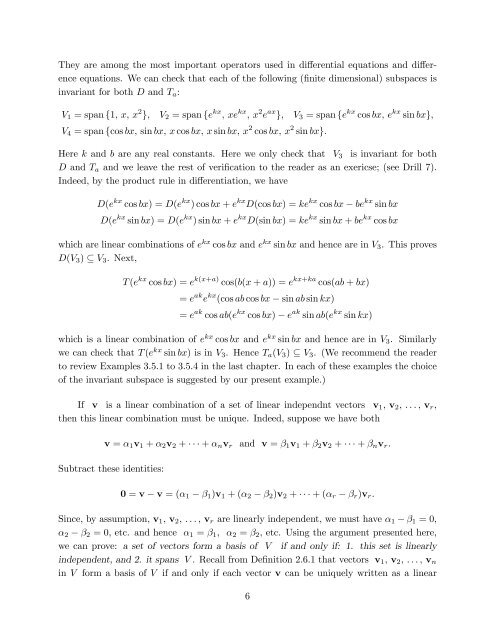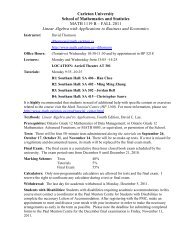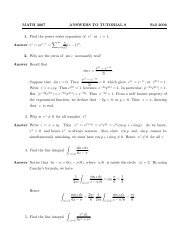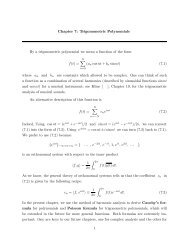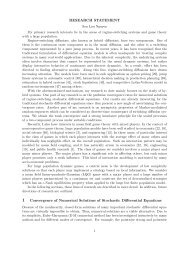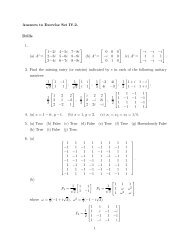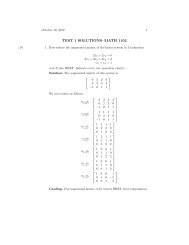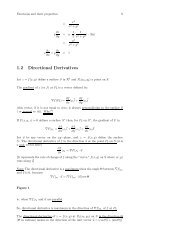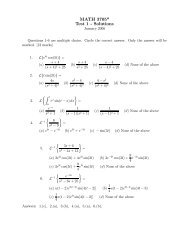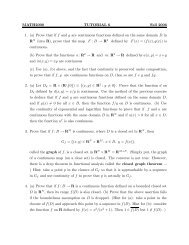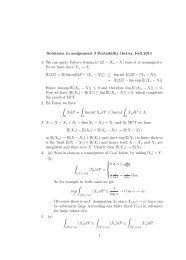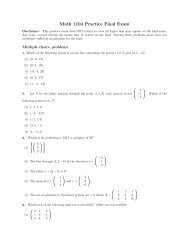CHAPTER II DIMENSION In the present chapter we investigate ...
CHAPTER II DIMENSION In the present chapter we investigate ...
CHAPTER II DIMENSION In the present chapter we investigate ...
Create successful ePaper yourself
Turn your PDF publications into a flip-book with our unique Google optimized e-Paper software.
They are among <strong>the</strong> most important operators used in differential equations and difference<br />
equations. We can check that each of <strong>the</strong> following (finite dimensional) subspaces is<br />
invariant for both D and Ta:<br />
V1 = span {1, x, x 2 }, V2 = span {e kx , xe kx , x 2 e ax }, V3 = span {e kx cos bx, e kx sin bx},<br />
V4 = span {cos bx, sin bx, x cos bx, x sin bx, x 2 cos bx, x 2 sin bx}.<br />
Here k and b are any real constants. Here <strong>we</strong> only check that V3 is invariant for both<br />
D and Ta and <strong>we</strong> leave <strong>the</strong> rest of verification to <strong>the</strong> reader as an exericse; (see Drill 7).<br />
<strong>In</strong>deed, by <strong>the</strong> product rule in differentiation, <strong>we</strong> have<br />
D(e kx cos bx) = D(e kx ) cos bx + e kx D(cos bx) = ke kx cos bx − be kx sin bx<br />
D(e kx sin bx) = D(e kx ) sin bx + e kx D(sin bx) = ke kx sin bx + be kx cos bx<br />
which are linear combinations of e kx cos bx and e kx sin bx and hence are in V3. This proves<br />
D(V3) ⊆ V3. Next,<br />
T (e kx cos bx) = e k(x+ a) cos(b(x + a)) = e kx+ ka cos(ab + bx)<br />
= e ak e kx (cos ab cos bx − sin ab sin kx)<br />
= e ak cos ab(e kx cos bx) − e ak sin ab(e kx sin kx)<br />
which is a linear combination of e kx cos bx and e kx sin bx and hence are in V3. Similarly<br />
<strong>we</strong> can check that T (e kx sin bx) is in V3. Hence Ta(V3) ⊆ V3. (We recommend <strong>the</strong> reader<br />
to review Examples 3.5.1 to 3.5.4 in <strong>the</strong> last <strong>chapter</strong>. <strong>In</strong> each of <strong>the</strong>se examples <strong>the</strong> choice<br />
of <strong>the</strong> invariant subspace is suggested by our <strong>present</strong> example.)<br />
If v is a linear combination of a set of linear independnt vectors v1, v2, . . . , vr,<br />
<strong>the</strong>n this linear combination must be unique. <strong>In</strong>deed, suppose <strong>we</strong> have both<br />
v = α1v1 + α2v2 + · · · + αnvr and v = β1v1 + β2v2 + · · · + βnvr.<br />
Subtract <strong>the</strong>se identities:<br />
0 = v − v = (α1 − β1)v1 + (α2 − β2)v2 + · · · + (αr − βr)vr.<br />
Since, by assumption, v1, v2, . . . , vr are linearly independent, <strong>we</strong> must have α1 − β1 = 0,<br />
α2 − β2 = 0, etc. and hence α1 = β1, α2 = β2, etc. Using <strong>the</strong> argument <strong>present</strong>ed here,<br />
<strong>we</strong> can prove: a set of vectors form a basis of V if and only if: 1. this set is linearly<br />
independent, and 2. it spans V . Recall from Definition 2.6.1 that vectors v1, v2, . . . , vn<br />
in V form a basis of V if and only if each vector v can be uniquely written as a linear<br />
6


